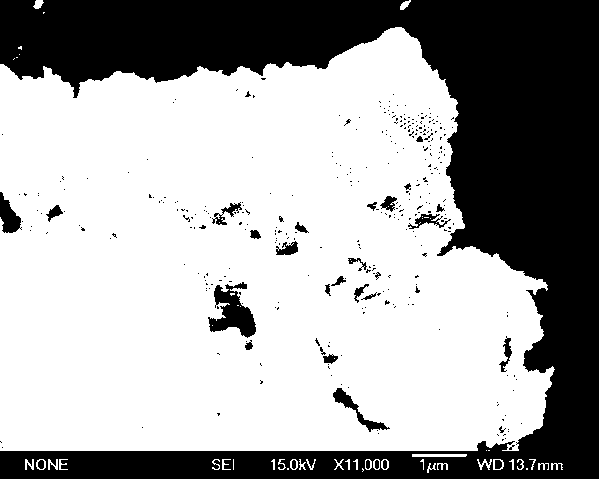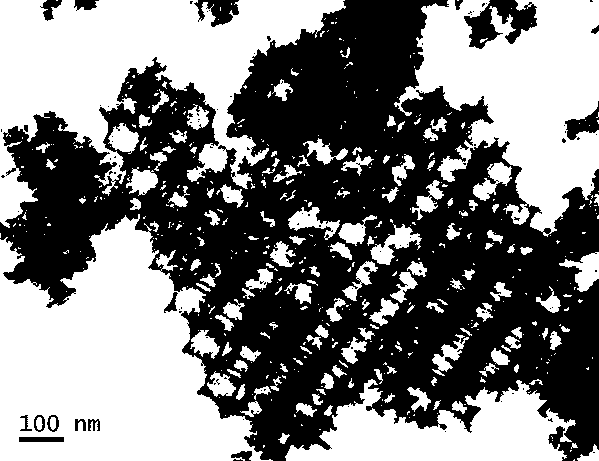Preparation method of denitration catalyst with nanoscale ordered honeycomb structure
A denitration catalyst, honeycomb structure technology, used in chemical instruments and methods, physical/chemical process catalysts, separation methods, etc.
- Summary
- Abstract
- Description
- Claims
- Application Information
AI Technical Summary
Problems solved by technology
Method used
Image
Examples
Embodiment 1
[0026] The preparation of catalyst: get styrene monomer and methacrylic acid, sodium bicarbonate and deionized water, after mixing with the mass ratio of 9:0.5:0.24:85, add the ammonium persulfate that massfraction is 0.3% in mixture as Initiator, under nitrogen protection, 85 o C, reacted under stirring conditions for 12h. The reaction products were subjected to evaporative self-assembly after centrifugal washing to prepare polystyrene templates. Cerium oxalate and zirconium silicate with a molar ratio of 8:2 are fully dissolved in a mixed solution of water, citric acid, and ethylene glycol with a mass ratio of 10:5:3, and then adsorbed by a polystyrene template and dried. The product was subsequently converted to 6 o C / min rate of heating up to 350 o C, calcined for 2 h, then heated to 750 o C, calcination for 5 h to obtain an ordered honeycomb framework of cerium-zirconium oxide. Disperse it with sodium tungstate at a mass ratio of 20:1 in deionized water, and evaporat...
Embodiment 2
[0029] The preparation of catalyst: get styrene monomer and methacrylic acid, after sodium bicarbonate and deionized water are mixed by the mass ratio of 10:1:0.24:85, add the ammonium persulfate that massfraction is 0.4% in the mixture as triggering agent, under nitrogen protection, 80 o C, reacted under stirring conditions for 10h. The reaction products were subjected to evaporative self-assembly after centrifugal washing to prepare polystyrene templates. Cerium carbonate and zirconium nitrate with a molar ratio of 7:3 were fully dissolved in a mixed solution of water, citric acid, and ethylene glycol with a mass ratio of 10:5:3, and then adsorbed by a polystyrene template and dried. The product was subsequently treated with 4 o C / min rate of heating up to 350 o C, calcined for 1.5 h, then heated to 650 o C, calcination for 4 h to obtain nanoscale ordered honeycomb framework of cerium-zirconium oxide. Disperse it and tungsten chloride in deionized water at a mass ratio ...
Embodiment 3
[0032] The preparation of catalyst: get styrene monomer and methacrylic acid, sodium bicarbonate and deionized water, after mixing by the mass ratio of 11:2:0.24:85, add the benzyl peroxide that massfraction is 0.5% in mixture Acyl as initiator, under nitrogen protection, 75 o C, reacted for 8h under stirring conditions. The reaction products were subjected to evaporative self-assembly after centrifugal washing to prepare polystyrene templates. Cerium nitrate and zirconium oxychloride with a molar ratio of 6:4 are fully dissolved in a mixed solution of water, citric acid, and ethylene glycol with a mass ratio of 10:5:3, and then adsorbed by a polystyrene template and dried. The product was subsequently treated with 2 o C / min rate of heating up to 350 o C, calcined for 2 h, then heated to 550 o C, performing a calcination treatment for 3 hours to obtain an ordered honeycomb framework of cerium-zirconium oxide. Disperse it and phosphotungstic acid in deionized water at a ma...
PUM
| Property | Measurement | Unit |
|---|---|---|
| pore size | aaaaa | aaaaa |
Abstract
Description
Claims
Application Information
 Login to View More
Login to View More - R&D
- Intellectual Property
- Life Sciences
- Materials
- Tech Scout
- Unparalleled Data Quality
- Higher Quality Content
- 60% Fewer Hallucinations
Browse by: Latest US Patents, China's latest patents, Technical Efficacy Thesaurus, Application Domain, Technology Topic, Popular Technical Reports.
© 2025 PatSnap. All rights reserved.Legal|Privacy policy|Modern Slavery Act Transparency Statement|Sitemap|About US| Contact US: help@patsnap.com


